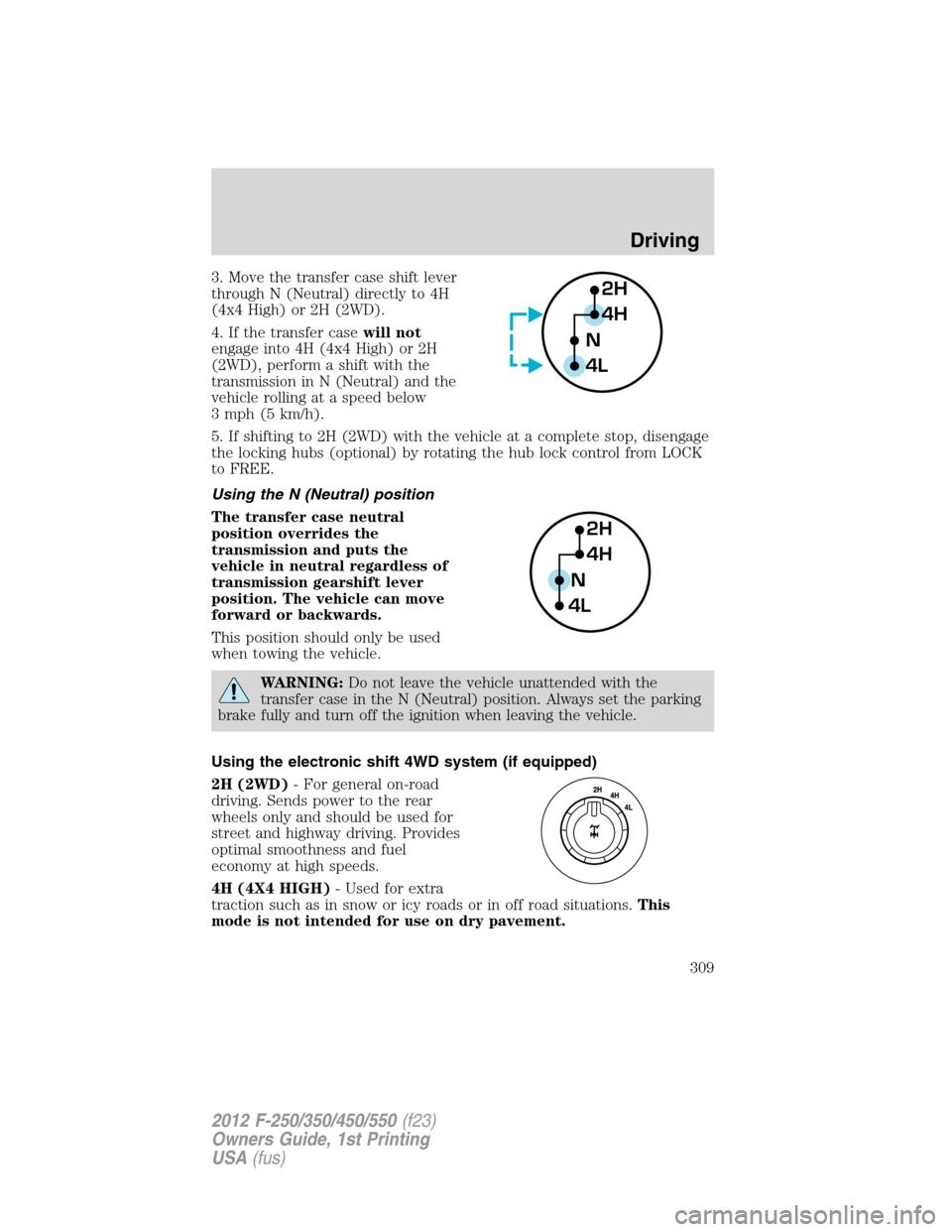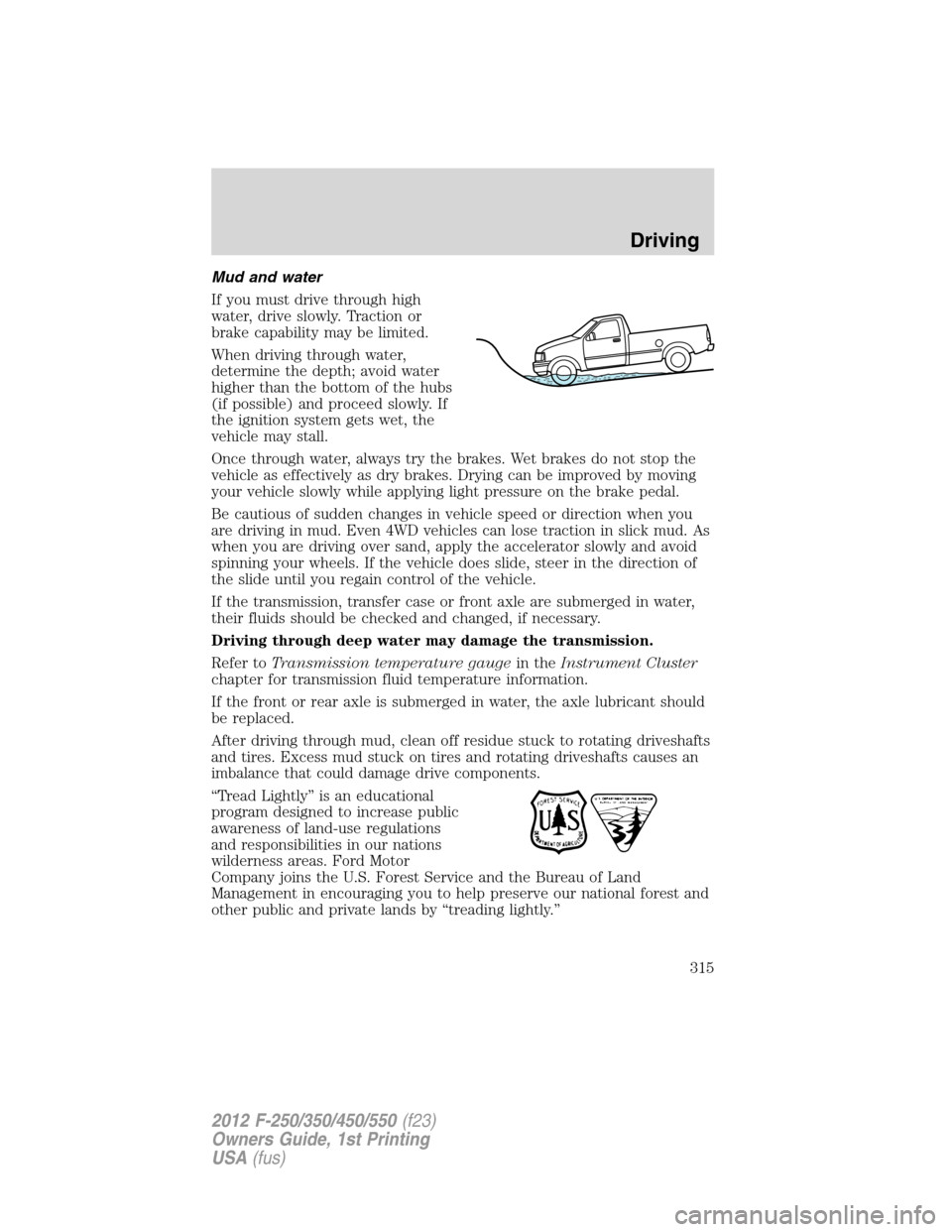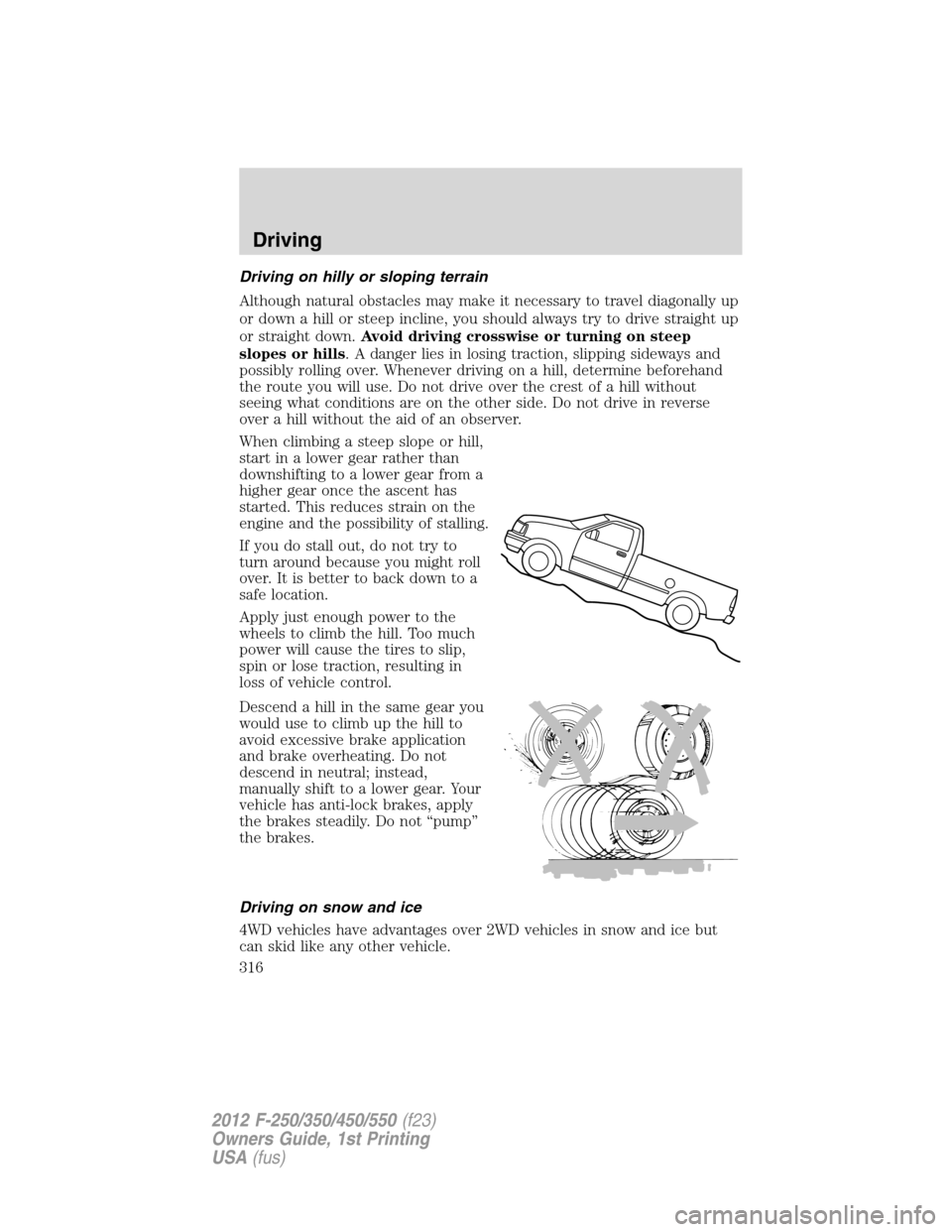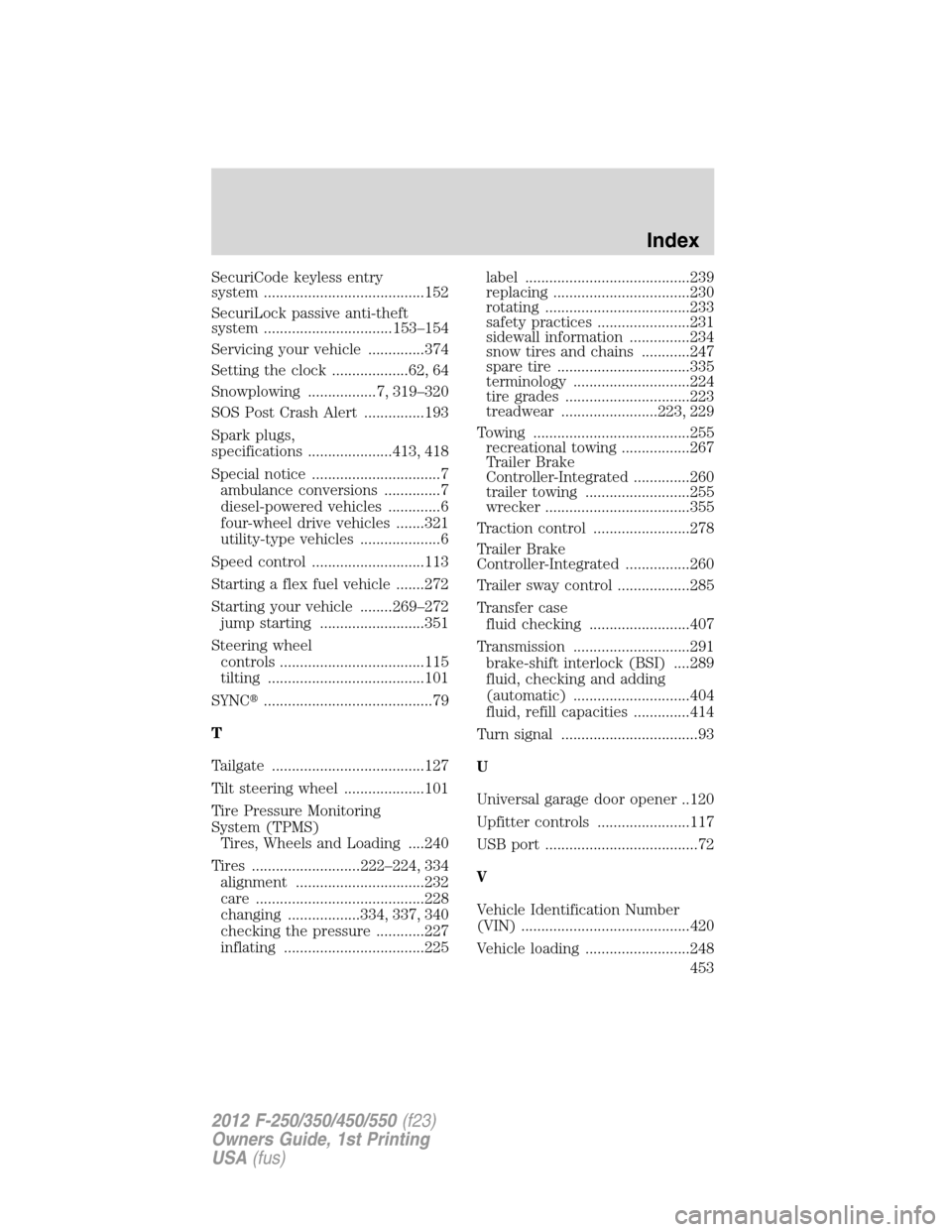Page 309 of 454

3. Move the transfer case shift lever
through N (Neutral) directly to 4H
(4x4 High) or 2H (2WD).
4. If the transfer casewill not
engage into 4H (4x4 High) or 2H
(2WD), perform a shift with the
transmission in N (Neutral) and the
vehicle rolling at a speed below
3 mph (5 km/h).
5. If shifting to 2H (2WD) with the vehicle at a complete stop, disengage
the locking hubs (optional) by rotating the hub lock control from LOCK
to FREE.
Using the N (Neutral) position
The transfer case neutral
position overrides the
transmission and puts the
vehicle in neutral regardless of
transmission gearshift lever
position. The vehicle can move
forward or backwards.
This position should only be used
when towing the vehicle.
WARNING:Do not leave the vehicle unattended with the
transfer case in the N (Neutral) position. Always set the parking
brake fully and turn off the ignition when leaving the vehicle.
Using the electronic shift 4WD system (if equipped)
2H (2WD)- For general on-road
driving. Sends power to the rear
wheels only and should be used for
street and highway driving. Provides
optimal smoothness and fuel
economy at high speeds.
4H (4X4 HIGH)- Used for extra
traction such as in snow or icy roads or in off road situations.This
mode is not intended for use on dry pavement.
2H
4H
4LN
2H
4H
4LN
Driving
309
2012 F-250/350/450/550(f23)
Owners Guide, 1st Printing
USA(fus)
Page 315 of 454

Mud and water
If you must drive through high
water, drive slowly. Traction or
brake capability may be limited.
When driving through water,
determine the depth; avoid water
higher than the bottom of the hubs
(if possible) and proceed slowly. If
the ignition system gets wet, the
vehicle may stall.
Once through water, always try the brakes. Wet brakes do not stop the
vehicle as effectively as dry brakes. Drying can be improved by moving
your vehicle slowly while applying light pressure on the brake pedal.
Be cautious of sudden changes in vehicle speed or direction when you
are driving in mud. Even 4WD vehicles can lose traction in slick mud. As
when you are driving over sand, apply the accelerator slowly and avoid
spinning your wheels. If the vehicle does slide, steer in the direction of
the slide until you regain control of the vehicle.
If the transmission, transfer case or front axle are submerged in water,
their fluids should be checked and changed, if necessary.
Driving through deep water may damage the transmission.
Refer toTransmission temperature gaugein theInstrument Cluster
chapter for transmission fluid temperature information.
If the front or rear axle is submerged in water, the axle lubricant should
be replaced.
After driving through mud, clean off residue stuck to rotating driveshafts
and tires. Excess mud stuck on tires and rotating driveshafts causes an
imbalance that could damage drive components.
“Tread Lightly” is an educational
program designed to increase public
awareness of land-use regulations
and responsibilities in our nations
wilderness areas. Ford Motor
Company joins the U.S. Forest Service and the Bureau of Land
Management in encouraging you to help preserve our national forest and
other public and private lands by “treading lightly.”
Driving
315
2012 F-250/350/450/550(f23)
Owners Guide, 1st Printing
USA(fus)
Page 316 of 454

Driving on hilly or sloping terrain
Although natural obstacles may make it necessary to travel diagonally up
or down a hill or steep incline, you should always try to drive straight up
or straight down.Avoid driving crosswise or turning on steep
slopes or hills. A danger lies in losing traction, slipping sideways and
possibly rolling over. Whenever driving on a hill, determine beforehand
the route you will use. Do not drive over the crest of a hill without
seeing what conditions are on the other side. Do not drive in reverse
over a hill without the aid of an observer.
When climbing a steep slope or hill,
start in a lower gear rather than
downshifting to a lower gear from a
higher gear once the ascent has
started. This reduces strain on the
engine and the possibility of stalling.
If you do stall out, do not try to
turn around because you might roll
over. It is better to back down to a
safe location.
Apply just enough power to the
wheels to climb the hill. Too much
power will cause the tires to slip,
spin or lose traction, resulting in
loss of vehicle control.
Descend a hill in the same gear you
would use to climb up the hill to
avoid excessive brake application
and brake overheating. Do not
descend in neutral; instead,
manually shift to a lower gear. Your
vehicle has anti-lock brakes, apply
the brakes steadily. Do not “pump”
the brakes.
Driving on snow and ice
4WD vehicles have advantages over 2WD vehicles in snow and ice but
can skid like any other vehicle.
Driving
316
2012 F-250/350/450/550(f23)
Owners Guide, 1st Printing
USA(fus)
Page 453 of 454

SecuriCode keyless entry
system ........................................152
SecuriLock passive anti-theft
system ................................153–154
Servicing your vehicle ..............374
Setting the clock ...................62, 64
Snowplowing .................7, 319–320
SOS Post Crash Alert ...............193
Spark plugs,
specifications .....................413, 418
Special notice ................................7
ambulance conversions ..............7
diesel-powered vehicles .............6
four-wheel drive vehicles .......321
utility-type vehicles ....................6
Speed control ............................113
Starting a flex fuel vehicle .......272
Starting your vehicle ........269–272
jump starting ..........................351
Steering wheel
controls ....................................115
tilting .......................................101
SYNC�..........................................79
T
Tailgate ......................................127
Tilt steering wheel ....................101
Tire Pressure Monitoring
System (TPMS)
Tires, Wheels and Loading ....240
Tires ...........................222–224, 334
alignment ................................232
care ..........................................228
changing ..................334, 337, 340
checking the pressure ............227
inflating ...................................225label .........................................239
replacing ..................................230
rotating ....................................233
safety practices .......................231
sidewall information ...............234
snow tires and chains ............247
spare tire .................................335
terminology .............................224
tire grades ...............................223
treadwear ........................223, 229
Towing .......................................255
recreational towing .................267
Trailer Brake
Controller-Integrated ..............260
trailer towing ..........................255
wrecker ....................................355
Traction control ........................278
Trailer Brake
Controller-Integrated ................260
Trailer sway control ..................285
Transfer case
fluid checking .........................407
Transmission .............................291
brake-shift interlock (BSI) ....289
fluid, checking and adding
(automatic) .............................404
fluid, refill capacities ..............414
Turn signal ..................................93
U
Universal garage door opener ..120
Upfitter controls .......................117
USB port ......................................72
V
Vehicle Identification Number
(VIN) ..........................................420
Vehicle loading ..........................248
Index
453
2012 F-250/350/450/550(f23)
Owners Guide, 1st Printing
USA(fus)
Page:
< prev 1-8 9-16 17-24